After an 11-year stint in the top flight came to an end last season, Southampton will be looking to bounce back to the Premier League at the first time of asking.
However, the task to do so and get out of the EFL Championship is no easy feat.
Whilst the Saints are competing at the right end of the table, only one point from the playoffs, the number of goals they are conceding is of genuine concern.
At the time of writing, Russell Martin’s side has the division’s worst defence.
They have conceded 16 in six matches and have failed to keep a clean sheet all season.
They also suffered an early exit in the EFL Cup, courtesy of a 3-1 defeat to EFL League Two side Gillingham.
Even though the Kent-based side are top of England’s fourth tier, they are one of the lowest scorers in their respective division.
The fact they were able to put three past the Championship side is a worry for the Saints.
In this tactical analysis and team-focused scout report, we will analyse Southampton’s current defensive record and provide an analysis of how it compares to previously promoted teams at this early stage of the season.
We will analyse the tactics deployed by Southampton, emphasising how it is contributing to their poor goals against tally.
Furthermore, we will explore how the recent summer transfer window has impacted their defensive capabilities.
Goals against hampering promotion prospects
It is early days in this new season, but Southampton are currently shipping goals.
It is difficult to contemplate them being in the promotion picture by the end of the campaign.
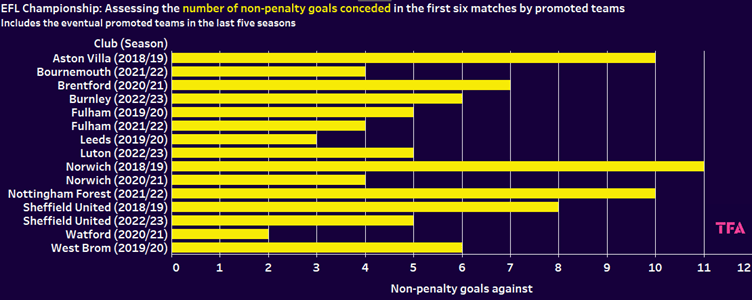
The graph confirms that the 16 non-penalty goals already conceded by the Saints are far more than the number conceded by any of the eventual promoted sides from the past five seasons at the same stage.
The average number of non-penalty goals conceded in the first six league matches by these previously promoted teams is just six.
Southampton, in contrast, has conceded nearly three times as many goals in the same period.
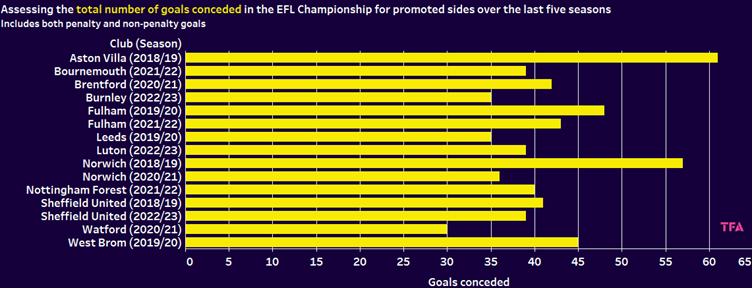
The graph above shows that the maximum any of the promoted sides in the past five seasons has conceded throughout the whole campaign is 61.
The average number of goals conceded throughout a whole season for the promoted teams is 42.
To put into context, the Saints are currently conceding 2.67 goals per match in the league.
On the basis there are still another 40 matches to play, Southampton can expect to concede a further 106 goals.
This would equate to conceding 122 goals for the league campaign.
This represents double the amount of the highest tally shown on the graph by Aston Villa in the 2018/19 season.
Martin’s side must look to address their current defensive plight.
They are currently underperforming as their goals against tally is greater than their expected goals against.
Based on the opportunities against them, it is expected that the Saints would have conceded 10 goals, which is six less than the reality.
It could be conceived that the poor defensive record could be attributed to the goalkeeper, Gavin Bazunu, who has the second-lowest save percentage of all goalkeepers who have played at least five matches in the division, at 50%.
However, the Hampshire side’s defensive struggles are more a product of their playing style.
High press leads to exposure at the back
Southampton manager Martin’s philosophy in playing football is for his team to be possession-based, as the more his side can control the ball, the more they will, in theory, control the game.
So far this season, they have averaged 67.7% possession, which is the highest in the division.
The Saints have predominantly lined up in a 4-3-3 formation with a single pivot in midfield to aid in the transition between defence and attack.
However, without the ball, the Saints’ formation shifts to a 4-1-3-2, as shown in the below match still.
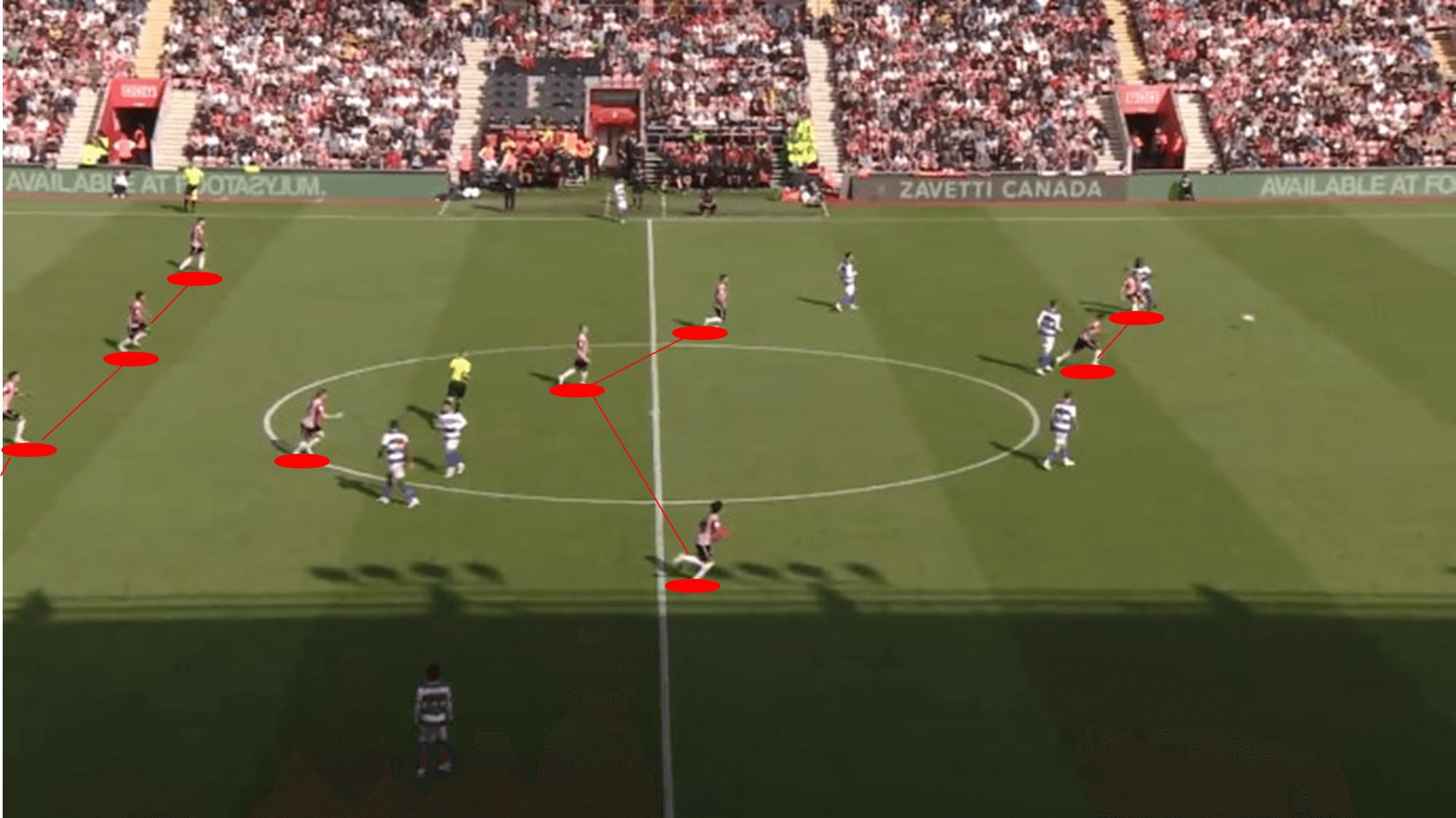
Out of possession, they apply a high press aiming to win the ball back deep in the opposition’s half and look to exploit any potential errors by the opposition defence.
This pressing approach has been executed well by the St Mary’s outfit, as they currently have the lowest number of passes per defensive action (PPDA) in the EFL Championship this season.
The low PPDA value of 7.8 indicates the high pressure adopted by Southampton.
From an attacking perspective, the adopted high press has led to a high return of goals, as only three teams have scored more in the league this season after six matches.
However, this has been to the detriment of the defence as the full-backs, Ryan Manning and Kyle Walker-Peters, join the high press, leaving space at the back for the opposition to exploit.

As QPR are in possession on the right-side channel, Southampton swarms the opposition and outnumber Rangers with an eight:six ratio, including the two full-backs.
However, despite the pressure applied by the Saints, QPR retained the ball and looked to advance play forward.
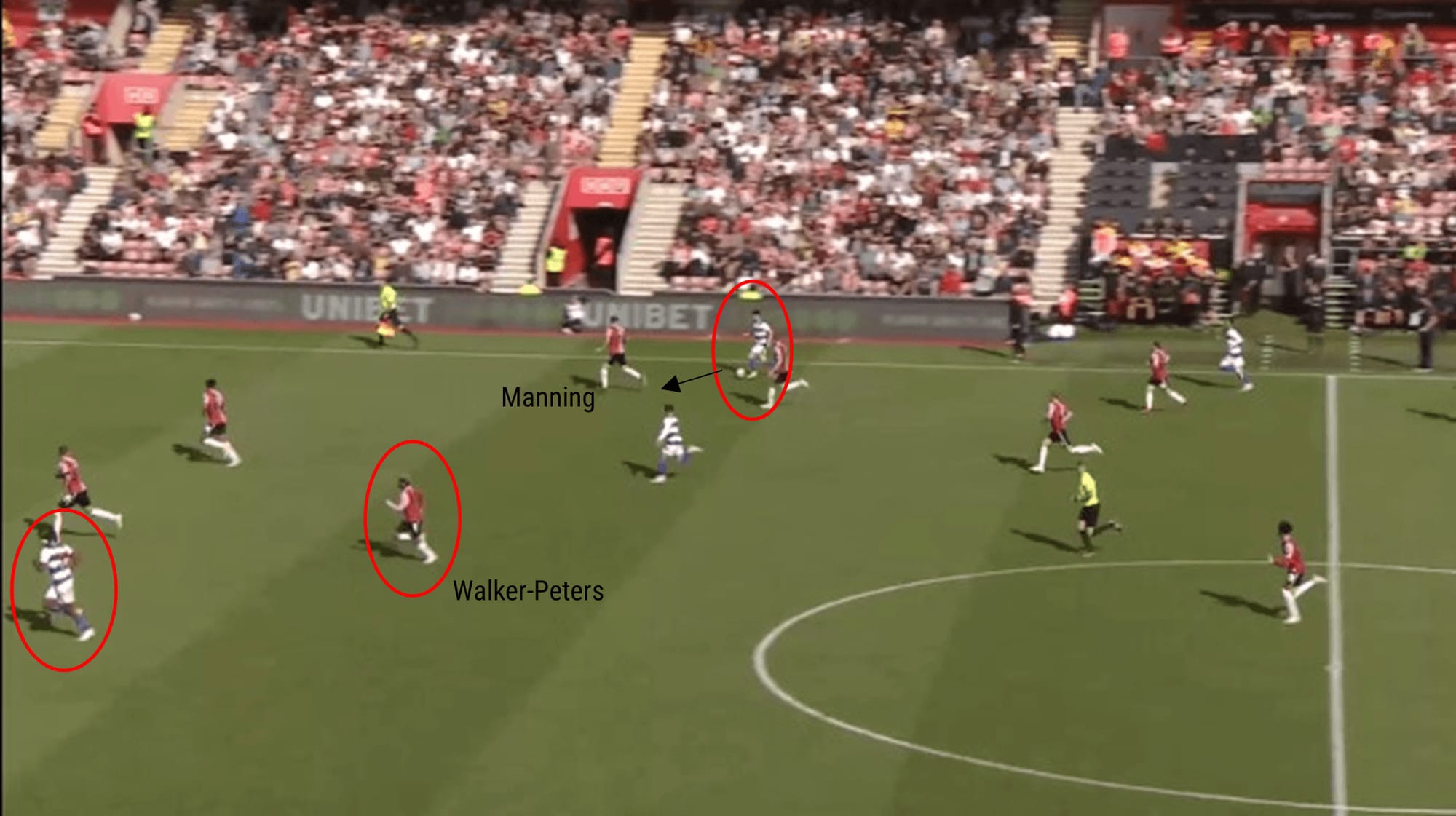
Manning is left to keep track of the opposition runner while Walker-Peters is forced to sprint back, as by this point, his previous advanced positioning has left the Rangers attacker with a free run at the back.
The nature of the Southampton tactics means the full-backs need to show athleticism as they will look to make overlapping runs going forward but also will need to recover at pace to ensure any counterattacks are dealt with.

The graphic shows that left-back Manning and right-back Walker-Peters, who have both been ever-present in the league this season, operate more so in the attacking half of the pitch.
This suggests they have been less disciplined in their defensive duties.
The defensive displays of the full-backs have been poor this campaign compared to those in the same position in England’s second tier.
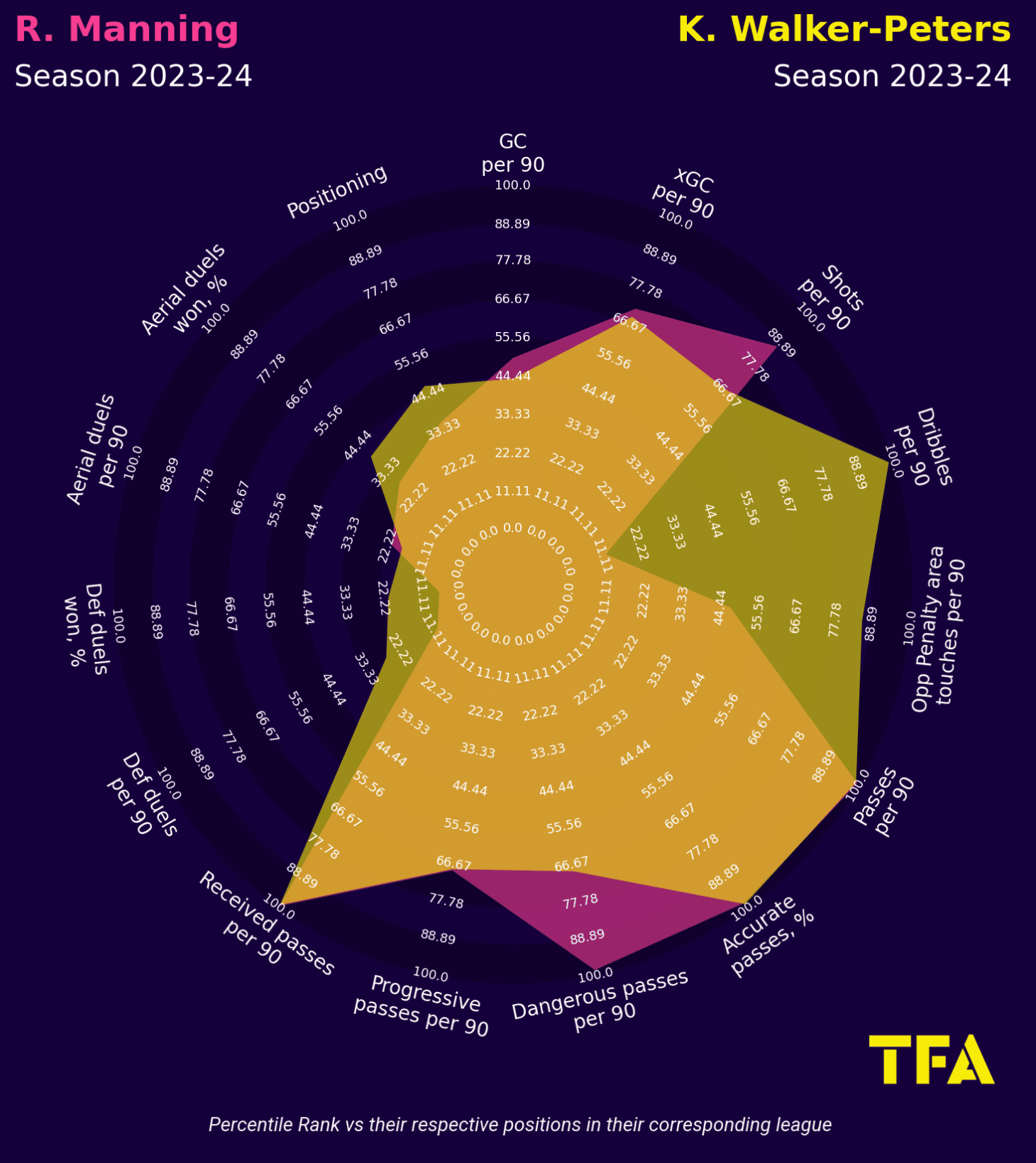
The radar chart shows that both full-backs rank highly in their progressive play and look to play dangerous passes.
This coincides with Southampton’s current record of making key passes, as they rank top for completed passes into the final third per 90 minutes in the Championship.
Walker-Peters is especially strong with dribbles and getting inside the opposition penalty area per 90 minutes.
It is suggested that Manning and Walker-Peters’ strengths lie in their attacking play and appear comfortable when in possession.
In contrast, the radar chart indicates Manning and Walker-Peters are weak when out of possession, as they rank below the median for their positional play.
Moreover, they both rank low for percentage of aerial duels and defensive duels won.
Despite the positives to the defender’s play in progressing the Saints further up the pitch, the principal job of a defender is to defend, and the data suggests a neglect in this department by the two.
The advanced positioning of the full-backs and the high line adopted by Southampton has made them vulnerable to counterattacks this season.
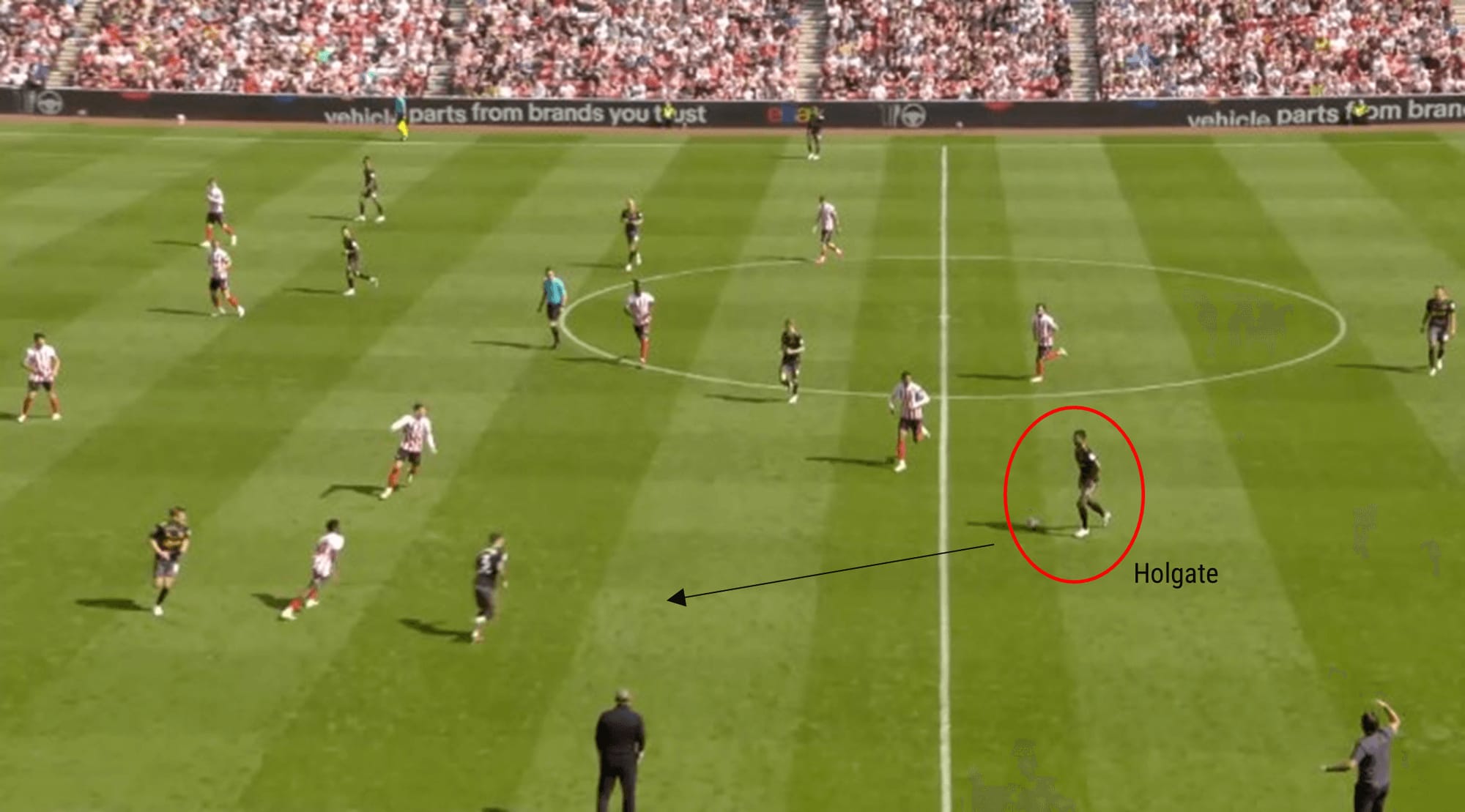
Southampton look to play out from the back under Martin and impose their possession-based football with Mason Holgate in control of the ball on the left side of the defensive partnership.
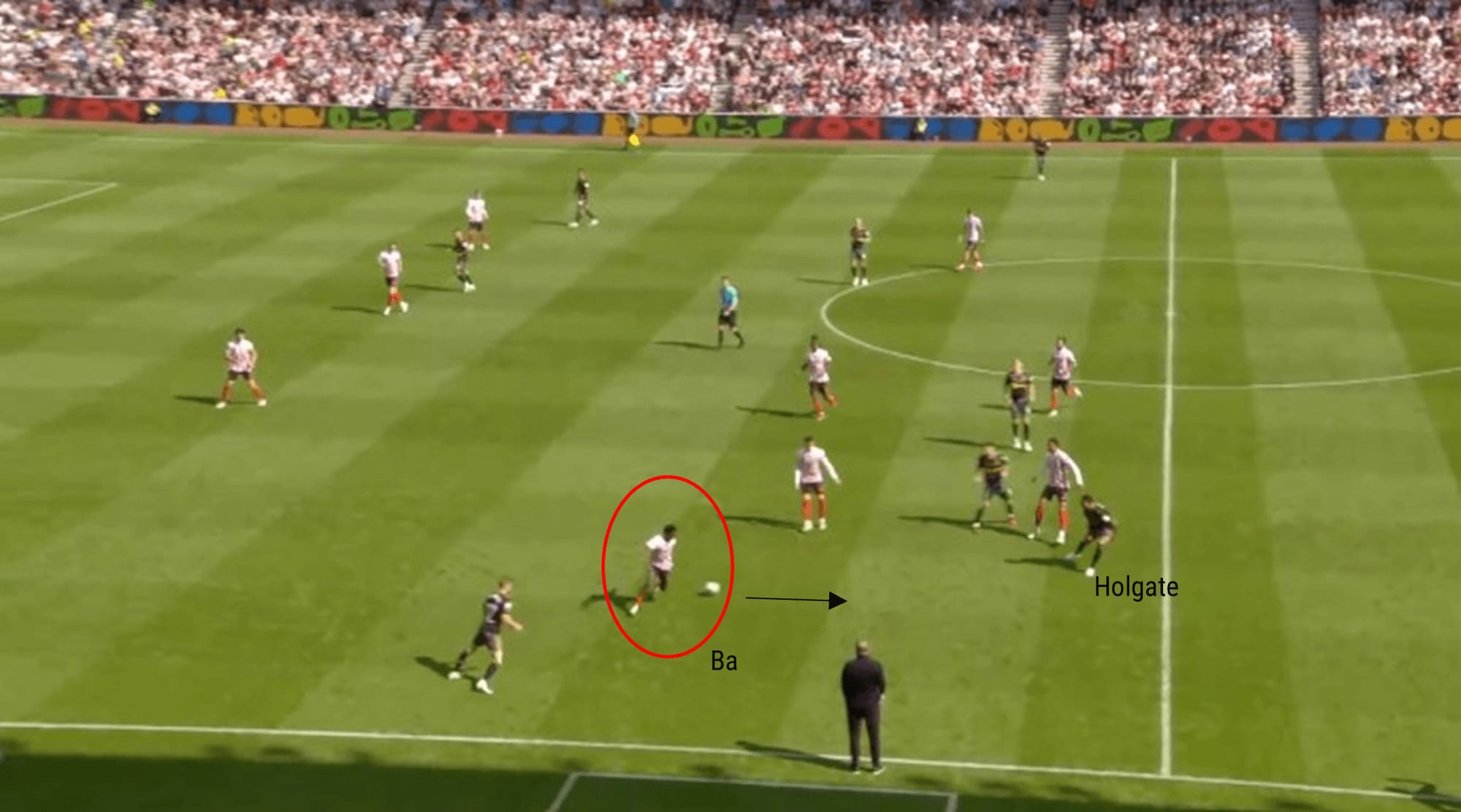
However, as Holgate distributed the ball out to the left wing, he misplaced his pass, which the Sunderland midfielder Abdoullah Ba intercepted.
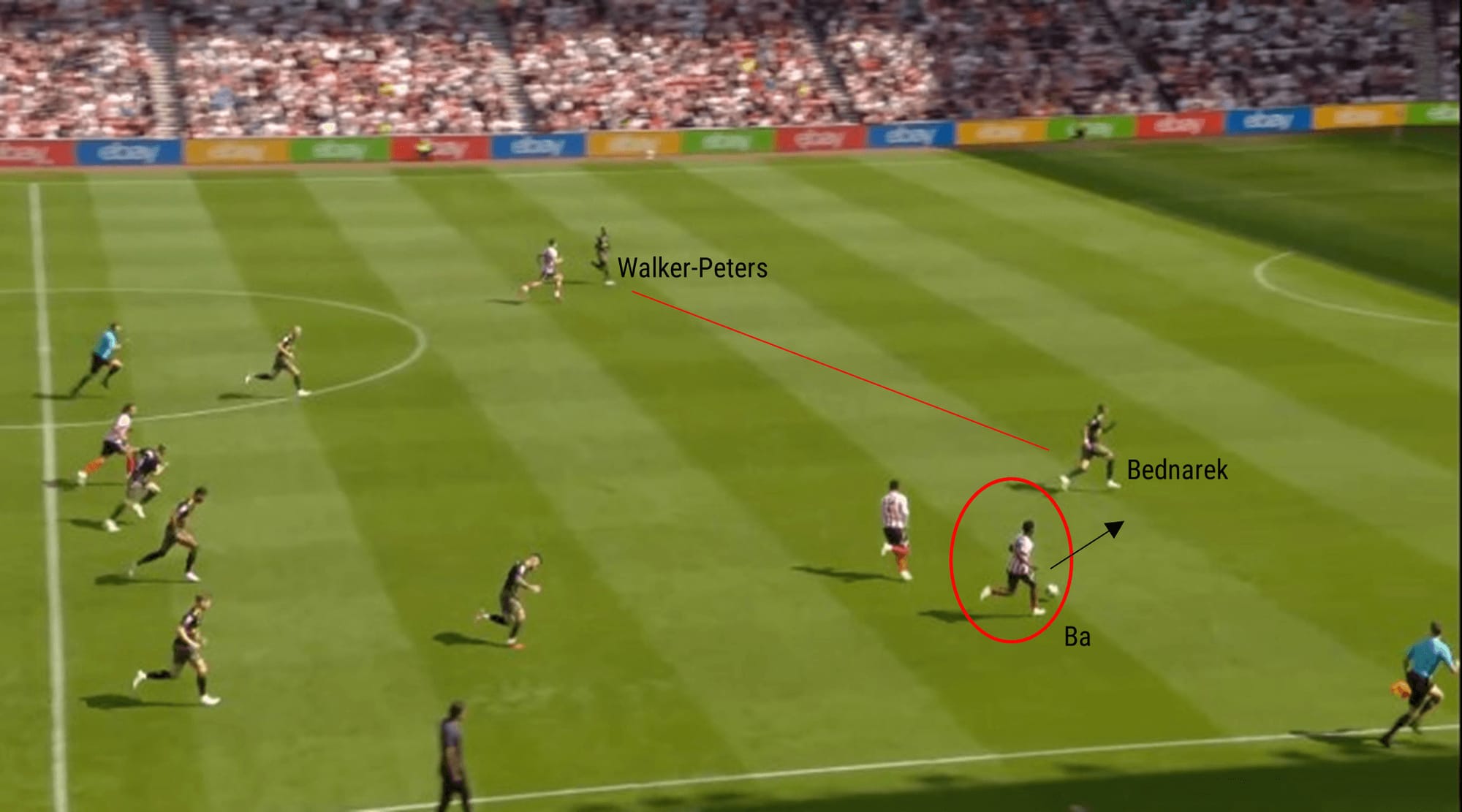
The Black Cats could bypass the Southampton midfield after some quick passing exchanges in the Sunderland midfield.
Ba was left to run at pace towards Jan Bednarek.
However, on this occasion, Ba’s eventual shot was off target.
It is noticeable in the above frame how an enormous amount of space was created during this counterattack as the Southampton backline was dismantled with only Bednarek and Walker-Peters left to cover.
Another example of their high line being exploited came in the 2-1 away victory at Plymouth.
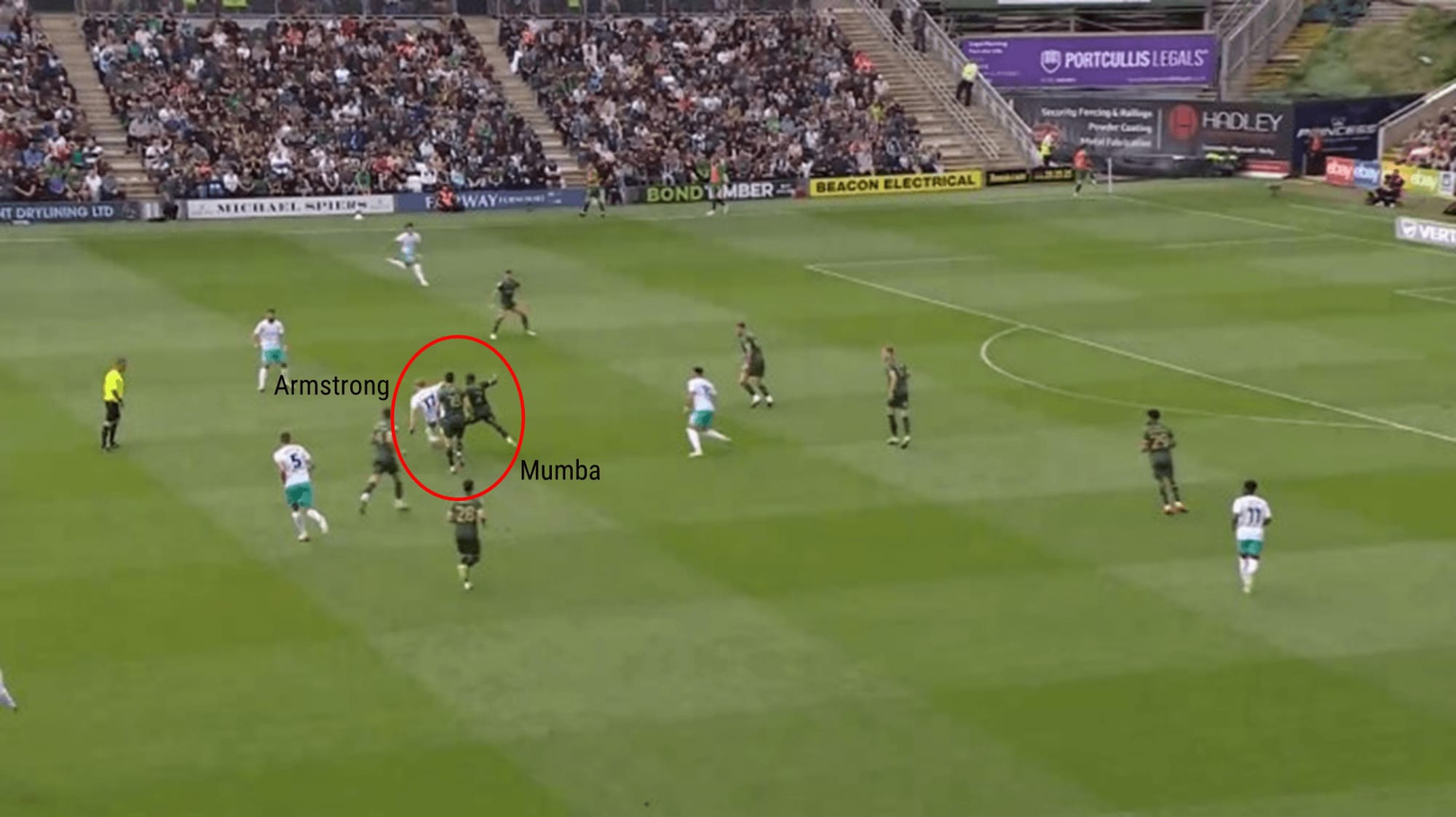
In the above image, Southampton midfielder Stuart Armstrong is tackled by Plymouth’s Bali Mumba, who then looks to progress his side forward.
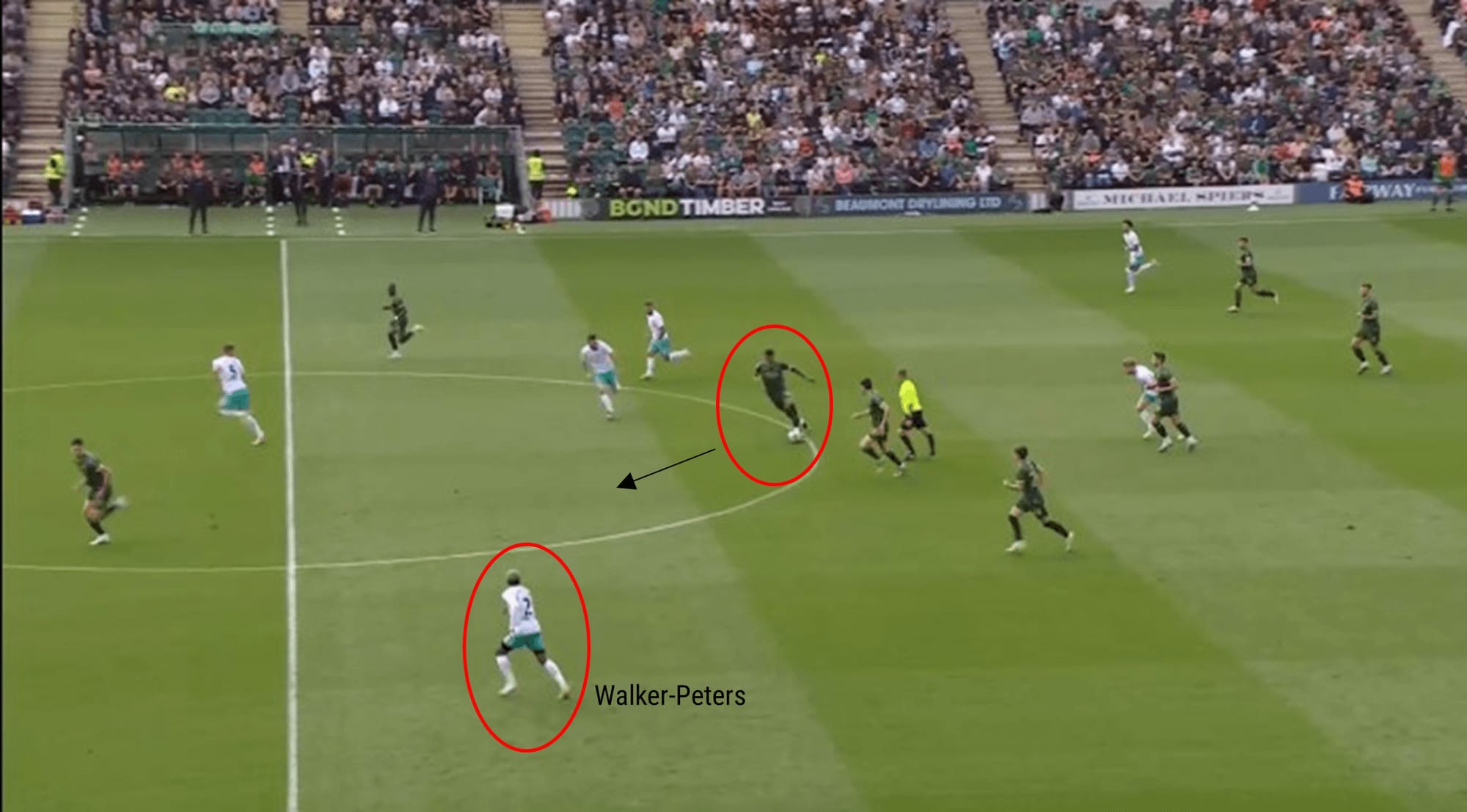
The Saints defence is forced to retreat to defend their goal quickly, but a sizeable gap is evident due to Walker-Peters’ advanced position in the opposition half.
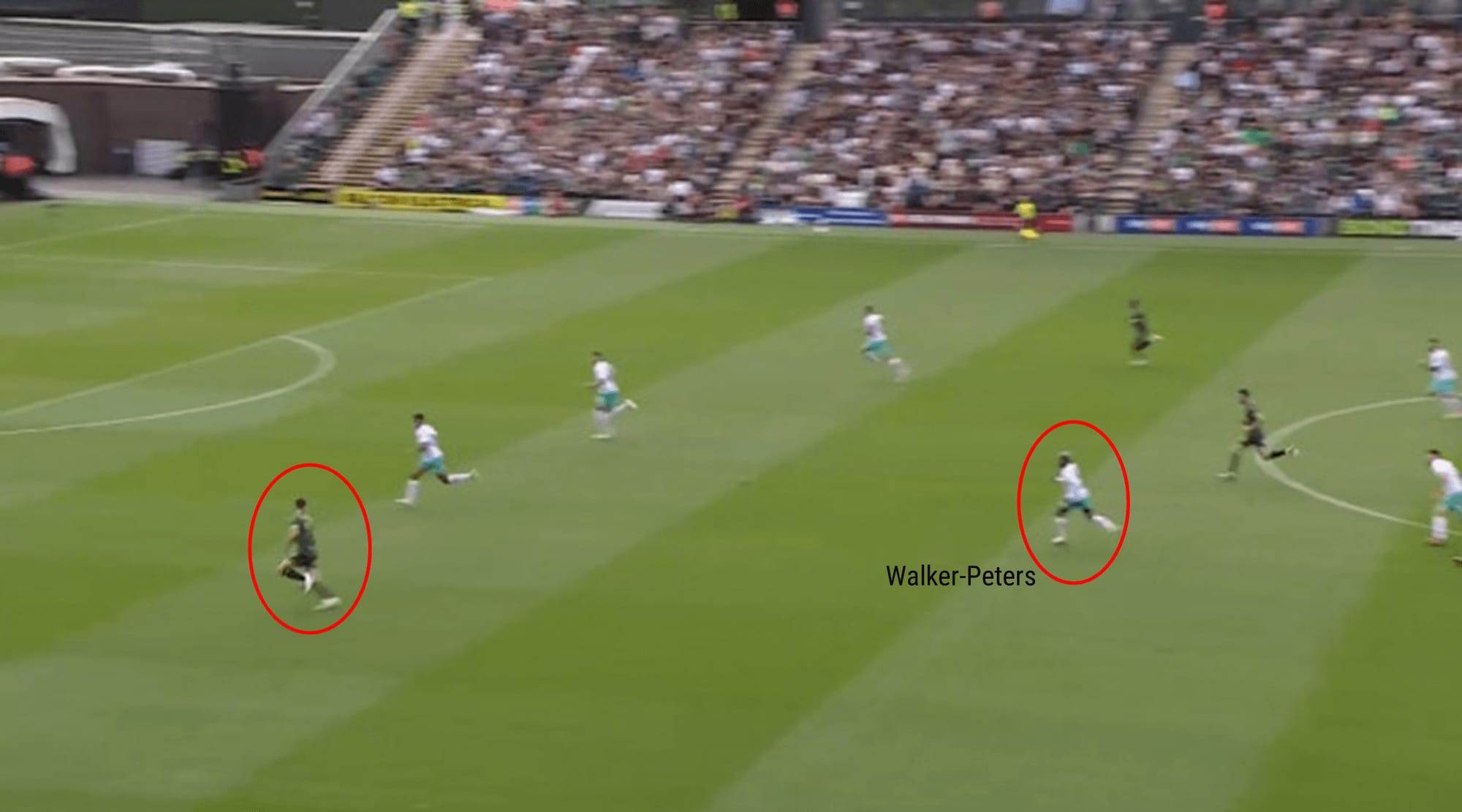
The ball is eventually played out to the left, and Plymouth are untroubled by the right-back.
Southampton are fortunate, however, as the resulting cross does not lead to a goal.
The defensive struggles and the disjoint between defence and midfield will not have been helped by the upheaval of player personnel this season.
There were 18 departures and eight arrivals at St Marys in the last transfer window.
A club in transition
The defensive centre-back partnership started consistently for Southampton with Bednarek and captain Jack Stephens.
However, the consistency came to a halt in the victory over QPR as Stephens went off injured.
The following match against Sunderland meant Everton loanee Holgate made his debut to replace the skipper.
The absence of Stephens was evident as the Saints were hammered 5-0.
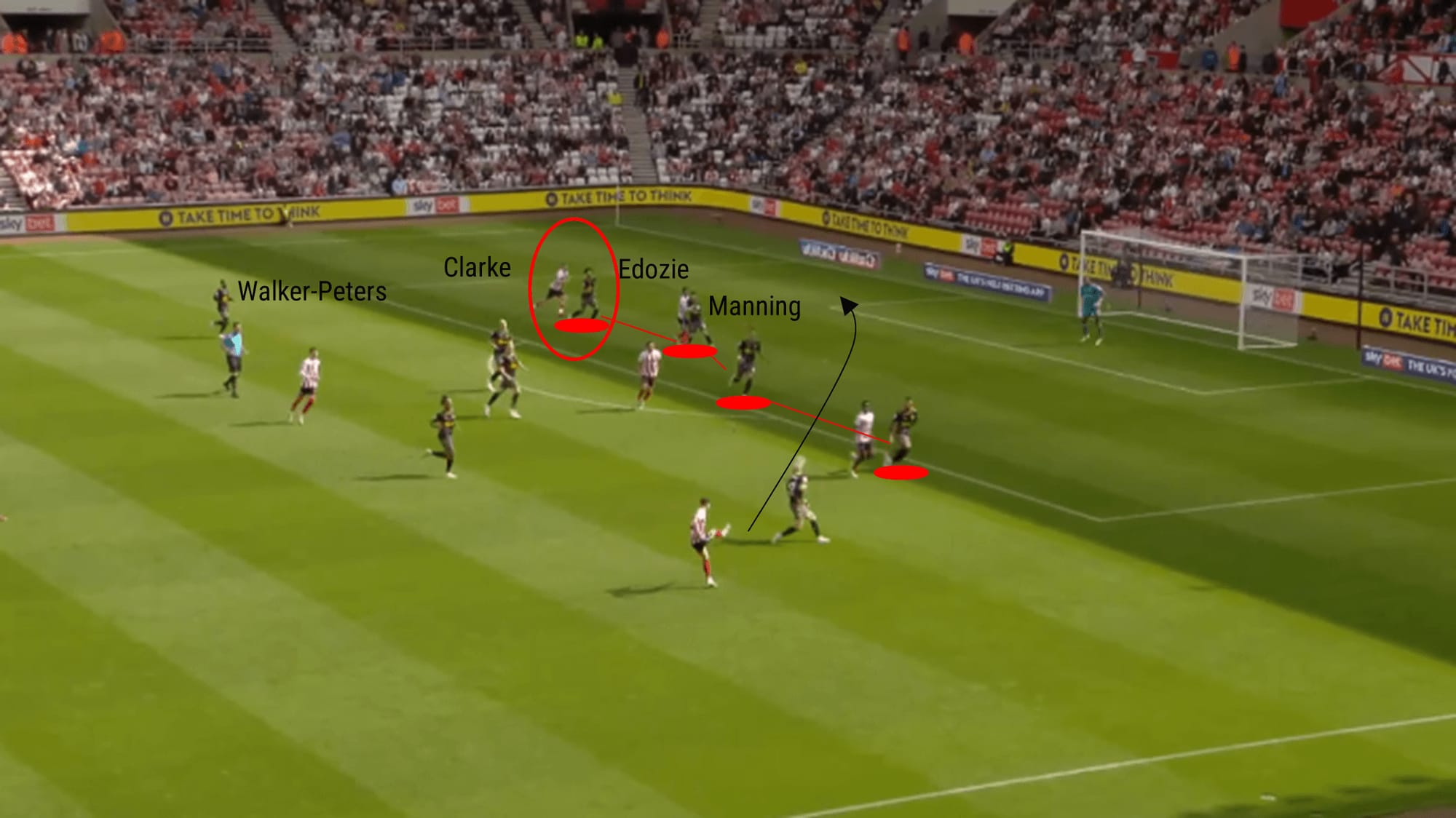
The image shows a disjointed backline, with Manning playing deeper than his defensive teammates and in a central position.
Manning’s positioning ensures that Jack Clarke stays onside; Clarke’s run was not tracked by Samuel Edozie.
The Sunderland midfielder was subsequently able to get on the end of the cross and head the Black Cats into the lead.
The backline shown here illustrates a lack of organisation and communication, as otherwise, the Saints may have been able to catch the Wearsiders offside.
During the international break, Bednarek joined Southampton’s injury list.
Therefore, in the most recent fixture against Leicester, Martin opted for Manchester City loanee Taylor Harwood-Bellis and recent acquisition, Shea Charles at the back.
Harwood-Bellis was part of the promotion-winning side at Burnley last season and is a defender who is comfortable on the ball, looking to initiate attacking movements.
He ranked in the 97th percentile for progressive passes per 90 last season in the Championship.
Charles has proved his versatility this campaign, as prior to his centre-back duties, he also featured in the single pivot role in defensive midfield.
The 4-1 home defeat to Leicester was the first time Harwood-Bellis and Charles played alongside each other.
Despite the positive attributes of these players, the defensive duo struggled, as too often, the Foxes’ attack was left with space to exploit.
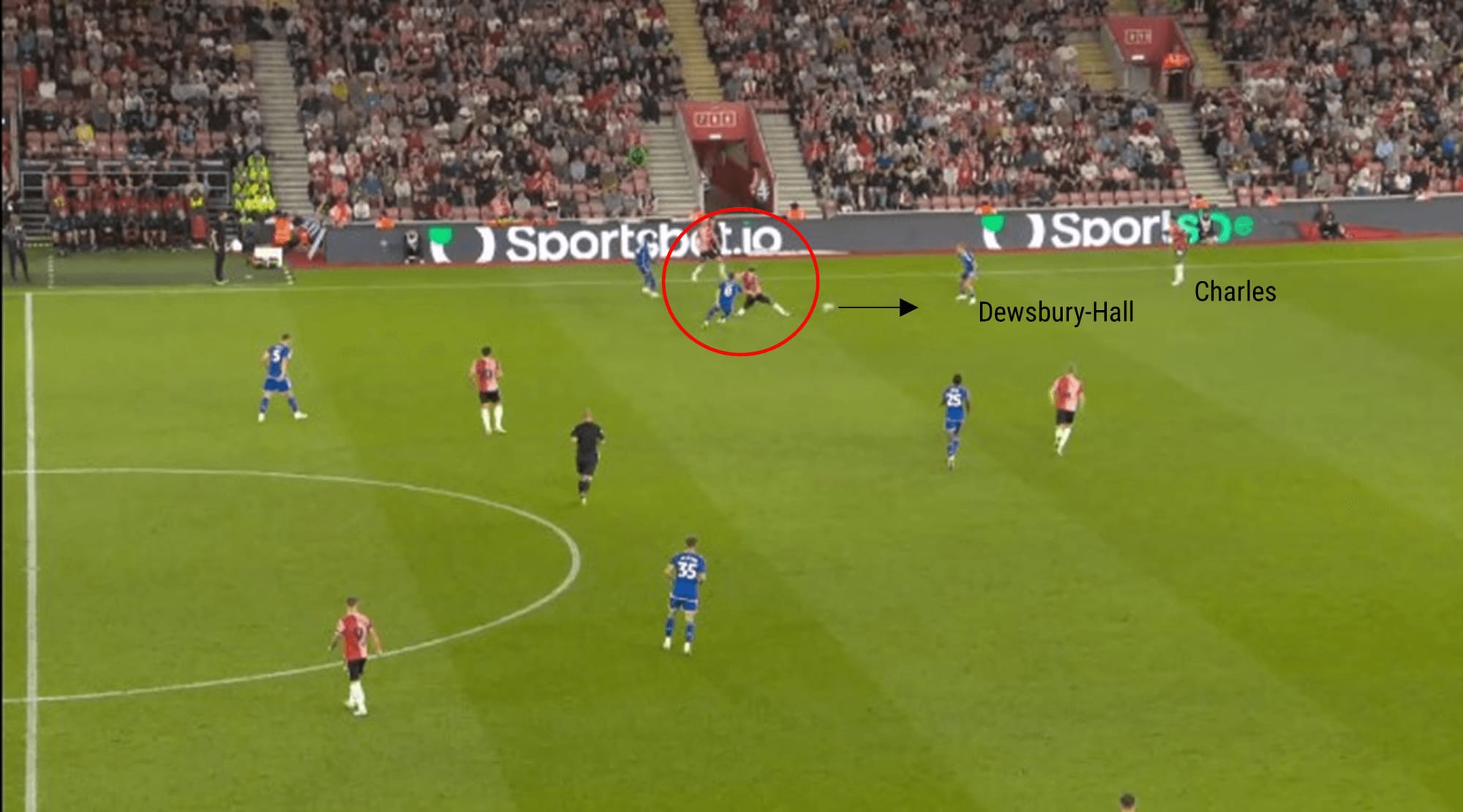
In the above graphic, Martin’s side play the ball out from the back from a goal kick but lose possession.
The ball falls to Leicester’s Keirnan Dewsbury-Hall.
It is noticeable from the above graphic that Charles is positioned out wide, leaving the Saints exposed at the back.
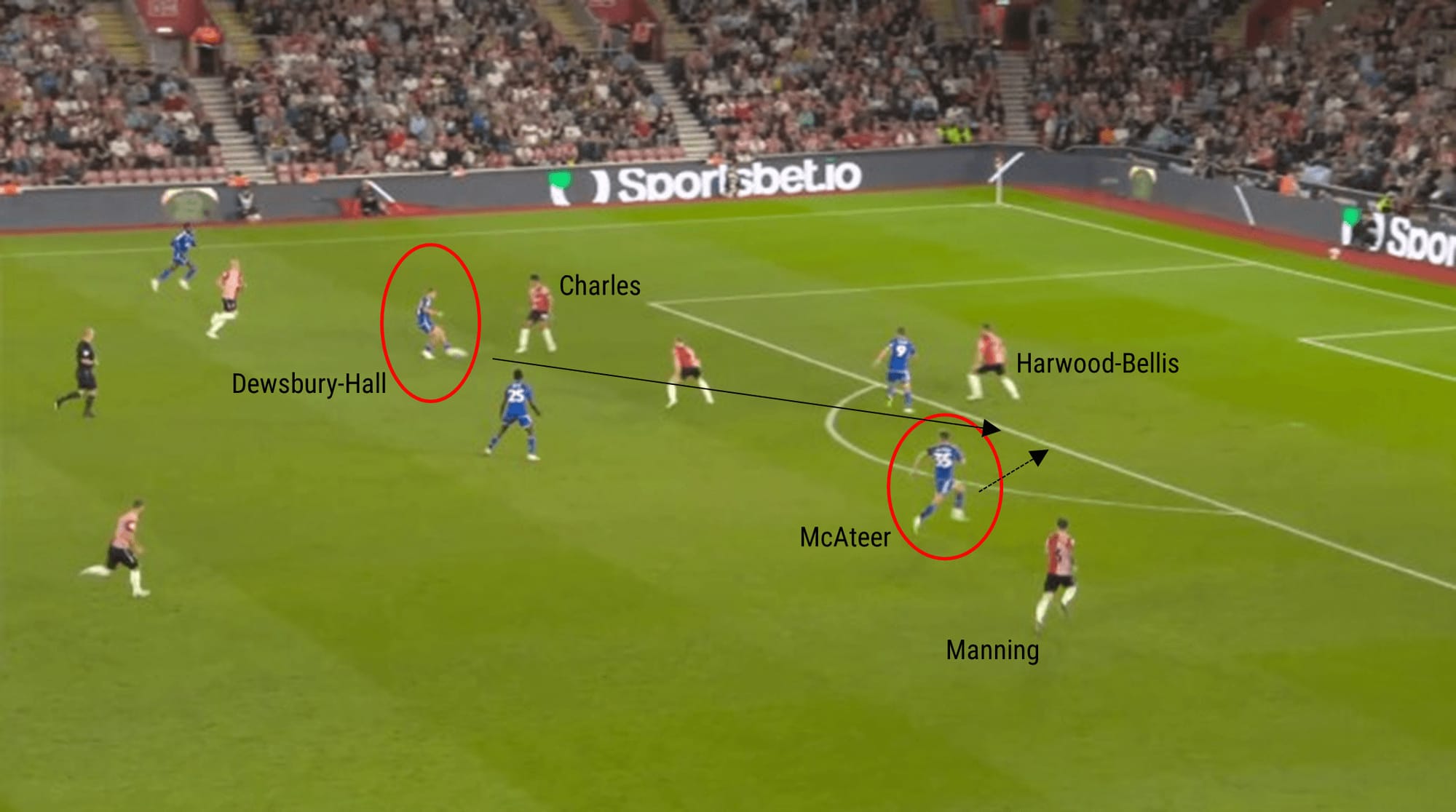
As Dewsbury-Hall advances with the ball, Manning tracks back but is already behind Leicester’s Kasey McAteer, who is unmarked with a free run on goal.
McAteer is picked out by his teammate and doubles the Foxes’ lead.
The amount of space left between the midfield and defence throughout this current 2023/24 season has been a recurring theme.
Following the inevitable departure of James Ward-Prowse to West Ham, as well as new signing Charles, Will Smallbone and Flynn Downes have been tried and tested in the single pivot role in midfield.
The single-pivot midfielder is crucial in aiding the transition from defence to attack and can step back into defence when needed.
The amount of reshuffling in this position will likely not have helped the Saints as a lack of understanding amongst the players is probable, as they are yet to fully understand one another’s game.
The trio that has stepped into the midfield role since the departure of Ward-Prowse has so far lacked in quality consistently.
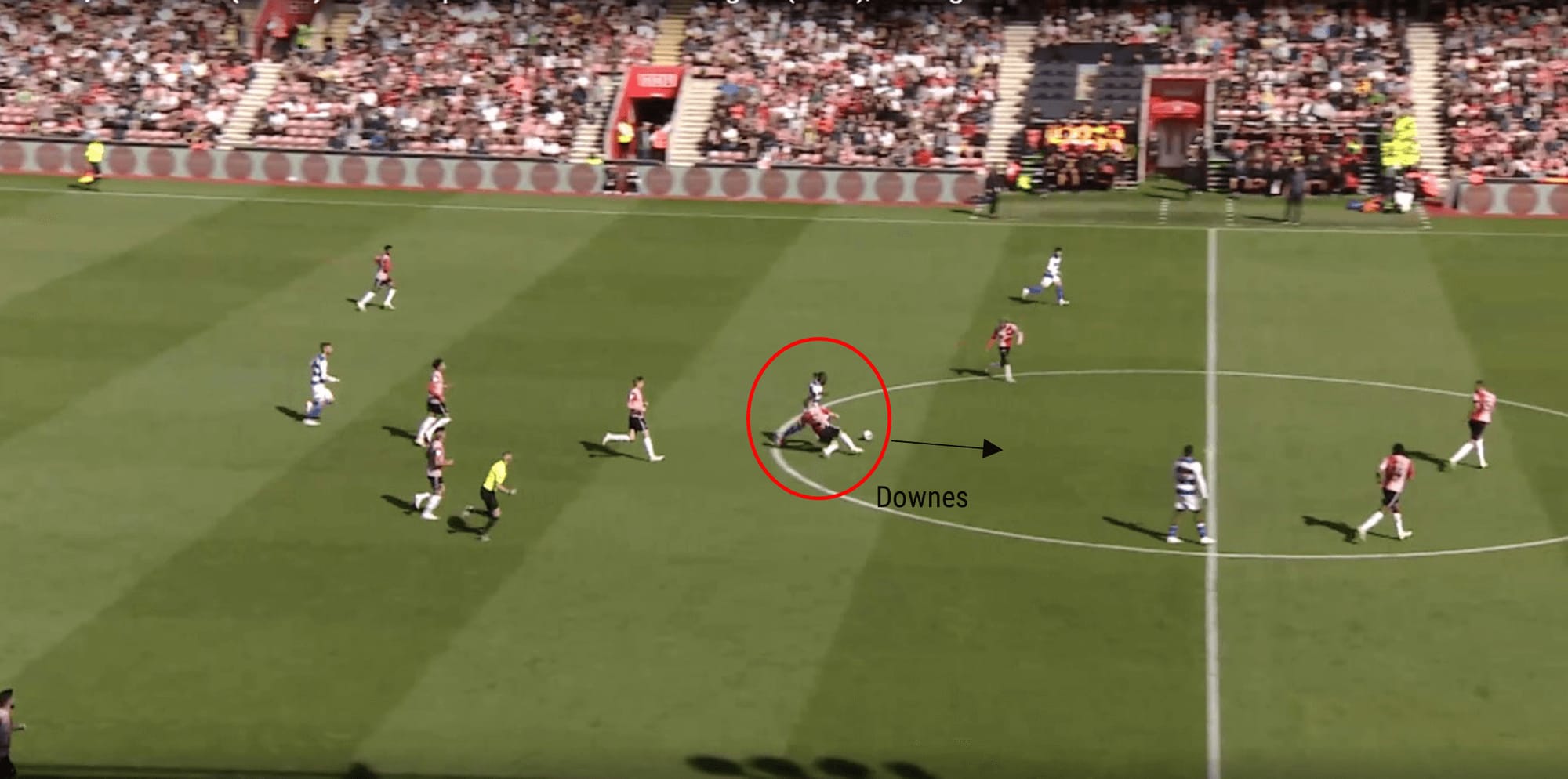
In the victory over QPR, Downes is seen going in for a tackle but cannot come away with the ball.
QPR subsequently continued their counterattack.
Since his arrival on the South Coast, Downes has struggled defensively.
He has only won 35.7% of his defensive duels.
In the defeat to Leicester, a different approach was adopted by Southampton with the introduction of 4-4-2.
However, the attacking nature of the recently relegated side and insistence on high positioning still left the Saints vulnerable at the back.

The still shows that as Leicester regained possession, Smallbone became the deepest outfield player on the pitch for Southampton.
Leicester midfielder Stephy Mavididi could go around Smallbone, who lacked pace, and Mavididi was subsequently left one-on-one with the goalkeeper.
The midfielder went on to score the East Midlands side’s fourth goal of the game, this goal proving to be the latest in the 16 Southampton have so far conceded in the league this season.
Conclusion
In this tactical analysis, we discussed Southampton’s current defensive struggles.
We have shown that their current goals conceded per game is above average when compared to previously promoted sides at the same stage.
We have also discussed how the Saints are presently underperforming in terms of goals conceded.
This analysis has further determined that tactically, a high press has left them vulnerable to counterattacks and being exploited by the opposition.
We have also identified that the new personnel in the dressing room have led to a lack of consistency in the team line-up.
In order to be considered serious contenders for promotion to the Premier League, Southampton will undoubtedly need to shore up their defence.






Comments